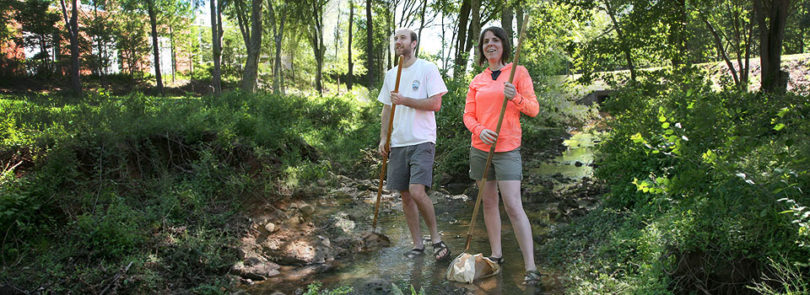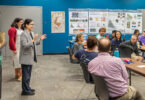With the launch of Watershed UGA in April, students now have the opportunity not only to learn about campus waterways but to help restore them to health.
A multidisciplinary initiative spearheaded by the Odum School of Ecology and the Office of Sustainability with funding from the Ray C. Anderson Foundation, Watershed UGA will engage students across campus through teaching, research, public service and outreach and campus physical operations to provide a transformative, hands-on experience in sustainability while helping to solve a real-world problem on campus.
According to Laurie Fowler, associate dean in the Odum School and leader of the multidisciplinary service-learning Environmental Practicum course, Lilly Branch and Tanyard Creek, which run through campus, are affected by a host of issues common to urban streams. These include excessive stormwater runoff that carries oil and other pollutants from roads and parking lots, eroding banks and an influx of invasive species. Leaking sewer pipes and pet waste are also a source of bacterial pollutants in the watershed.
UGA and Athens-Clarke County have committed to work together to restore these streams to health. For the past several years, UGA students have been studying the streams through courses in a variety of areas including ecology, public health, hydrology, environmental law and landscape architecture. Students in the environmental practicum and other courses worked with Athens-Clarke County officials to develop a restoration plan.
Students and staff across campus have helped to implement some of its recommendations, including such innovative projects as using goats and sheep-the “Chew Crew”-in invasive plant control and constructing attractive rain gardens to manage stormwater in critical locations. And UGA students have been working with elementary school classes within the watersheds to provide age-appropriate environmental service-learning education.
Watershed UGA will scale up all these efforts, bringing the restoration of campus waterways to the entire campus community through classrooms, housing communities and research and service activities.
“We have a tremendous opportunity to engage the campus community in sustainability through campus watersheds, expanding experiential learning opportunities and fostering a sense of place among faculty, staff and students at UGA,” said Tyra Byers, program coordinator in the Office of Sustainability.
Phase one, to introduce a set of educational modules, got underway at two standing-room only workshops in April. The modules, developed by graduate students in upper level ecology and landscape architecture courses with the help of graduate assistants in the Center for the Integration of Research, Teaching and Learning, are designed to help faculty incorporate sustainability into their curriculum in classes ranging from biology to art.
Next, more service-learning activities will be developed over the summer, and the campus life component of the project-which will include a social media campaign, inter-dorm competitions and other events-will kick off next fall.
Watershed UGA is a partnership between the Odum School of Ecology, the Office of Sustainability, Vice President for Public Service and Outreach, the Center for Teaching and Learning, the Center for the Integration of Research, Teaching and Learning, the Franklin College of Arts and Sciences, the College of Education, the College of Engineering, the College of Environment and Design, the Warnell School of Forestry and Natural Resources, the School of Law, the College of Public Health, the Graduate School, the Facilities Management Division, the Office of Service-Learning, the Office of the University Architects for Facilities Planning, University Housing and Athens-Clarke County.
For more information and to learn how you can get involved, see www.watershed.uga.edu or contact Elizabeth Gardner at ehgard@uga.edu.
-Beth Gavrilles, Odum School of Ecology







